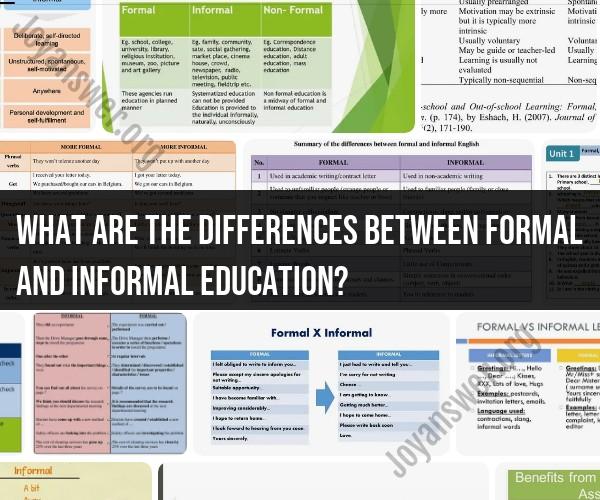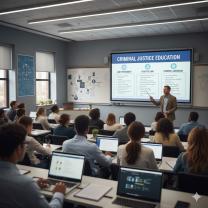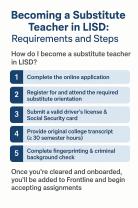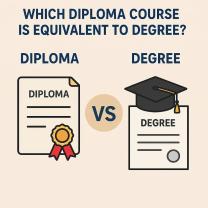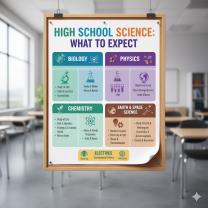What are the differences between formal and informal education?
Formal education and informal education are two distinct approaches to learning, and they differ in various ways. Here are the key differences between formal and informal education:
Formal Education:
Structured Setting: Formal education takes place within a structured and organized environment, such as schools, colleges, and universities. It follows a predefined curriculum and schedule.
Certification: Formal education typically results in the attainment of degrees, diplomas, or certificates, which are recognized by educational institutions and employers.
Qualified Instructors: Instructors or teachers in formal education settings are usually trained, qualified, and follow specific teaching methodologies.
Standardized Assessment: Students in formal education are assessed through standardized tests, assignments, and examinations. The assessment criteria are often uniform for all students.
Learning Objectives: Formal education has predefined learning objectives and goals that students are expected to achieve within a specified timeframe.
Structured Subjects: Education in formal settings is divided into subjects or courses, and students progress through a predetermined sequence of topics.
Time-Bound: Formal education has set schedules and timelines, including academic calendars and fixed class hours.
Cost: Formal education often involves tuition or fees, and the cost can vary depending on the level of education and the institution.
Accountability: Formal education institutions are accountable to educational authorities, and there are regulations and standards they must adhere to.
Informal Education:
Unstructured Setting: Informal education occurs in everyday life, without a formal curriculum or structured environment. It can happen anywhere, such as at home, in the community, or through personal experiences.
No Certification: Informal education typically does not lead to formal degrees or certificates, although it can provide valuable knowledge and skills.
Diverse Instructors: Informal education can be facilitated by a wide range of people, including family members, peers, mentors, and self-directed learning.
Varied Assessment: Informal learning may not involve traditional assessments. Instead, individuals often gauge their progress through personal reflection and practical application.
Self-Directed: Learners in informal settings have more autonomy and control over their learning. They choose what, when, and how they learn.
Flexible Topics: Informal education is not bound by specific subjects or courses. It can encompass a wide range of topics and skills based on personal interests and needs.
No Fixed Schedule: Informal education is flexible in terms of timing and does not follow a rigid schedule.
Low or No Cost: Many informal educational opportunities are low-cost or free, making them accessible to a broader audience.
Less Regulation: Informal education is less regulated and standardized compared to formal education. It can adapt to individual needs and preferences.
In summary, formal education is structured, certified, and follows a set curriculum, whereas informal education is unstructured, self-directed, and occurs outside formal institutions. Both types of education have their own advantages and can complement each other in a person's lifelong learning journey.
Contrasting Formal and Informal Education: Key Differences
| Characteristic | Formal Education | Informal Education |
|---|---|---|
| Structure | Highly structured, with predetermined learning objectives, curriculum, and assessments | Flexible and unstructured, with learner-driven learning goals and activities |
| Setting | Typically takes place in a classroom or other formal setting | Can take place anywhere, at any time |
| Credentials | Can lead to academic degrees and other formal qualifications | Does not typically lead to formal credentials |
| Instructor-led | Learning is facilitated by a trained instructor | Learning is self-directed or facilitated by peers or mentors |
| Purpose | To prepare learners for specific careers or academic programs | To help learners develop their knowledge and skills for personal or professional growth |
Advantages and Disadvantages of Formal and Informal Learning
Formal Education
Advantages:
- Provides learners with a structured and supportive learning environment
- Offers a wide range of courses and programs to choose from
- Can lead to academic degrees and other formal qualifications
- Provides learners with the opportunity to network with other students and professionals
Disadvantages:
- Can be expensive
- Can be time-consuming
- May not be as flexible as informal learning
- May not be relevant to all learners' needs
Informal Education
Advantages:
- Is flexible and can be tailored to the learner's individual needs and interests
- Is often more affordable than formal education
- Can be more accessible than formal education, especially for learners who live in remote areas or have other commitments
- Can be more relevant to learners' real-world needs and experiences
Disadvantages:
- May not be as structured or supportive as formal education
- May not be as rigorous as formal education
- May not lead to formal credentials
- May be difficult to find qualified instructors or mentors
Blending Formal and Informal Education for Holistic Learning
Blending formal and informal education can provide learners with the best of both worlds. For example, learners can take formal courses to develop their foundational knowledge and skills, and then supplement their learning with informal activities such as reading books and articles, attending workshops and conferences, and networking with other professionals.
Here are a few tips for blending formal and informal education for holistic learning:
- Identify your learning goals: What do you want to learn and achieve? Once you know your goals, you can start to identify the best resources and activities for meeting them.
- Take advantage of formal education opportunities: Formal courses can provide you with a structured and supportive learning environment, and they can also lead to formal credentials. However, it is important to choose courses that are relevant to your learning goals and interests.
- Supplement your formal education with informal learning activities: There are many ways to learn outside of the classroom. You can read books and articles, attend workshops and conferences, network with other professionals, and participate in online courses and tutorials.
- Reflect on your learning: It is important to take time to reflect on your learning and identify areas where you need to improve. This will help you to develop a personalized learning plan that meets your individual needs.
By blending formal and informal education, learners can develop the knowledge, skills, and attitudes they need for success in their personal and professional lives.
